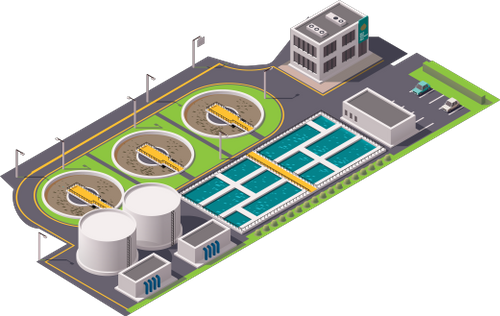Wastewater Treatment Plants
Wastewater Treatment Plant
What are they?

Wastewater treatment plants convert effluent (water that has been used for some industrial or public purpose) into water that can be either returned to the water cycle with minimal environmental issues or reused.
How do wastewater treatment plants impact water quality in the Bow River Basin?
Wastewater treatment plants remove large amounts of contaminants and organic matter from the wastewater stream, thereby improving water quality. However, the effluent from wastewater treatment plants can still have higher concentrations of nutrients and other contaminants than natural surface water. Therefore wastewater treatment plants are considered a “point source” of pollution in the environment.
The City of Calgary online tour provides an example of the processes undertaken at a wastewater treatment plant. When wastewater reaches a plant, it passes through screens that remove large materials such as plastic bags, toilet paper, paper towels, sticks and tennis balls. It then passes through a series of tanks where solids settle, and oils and grease are skimmed off the top. Effluent is then digested by microorganisms that remove much of the nutrients and organic material. Water is then clarified by settling, and finally, filtered and disinfected prior to being released into the river.
There are numerous contaminants in the wastewater stream which are not completely removed by wastewater treatment processes. Many of these contaminants are from everyday products (e.g., medicines, household materials) and their downstream impacts are not fully understood. Some of the contaminants that are not removed by the wastewater treatment process can impact aquatic species. More information can be found on the fact page for Emerging Contaminants.
What can we do about it?
The smooth operation and maintenance of our wastewater collection systems and treatment facilities depends, in large part, on what we collectively put down our drains. Grease, disposable wipes and hygiene products can cause local and systemic issues in collection systems and treatment facilities. Issues can include pipe clogging and disruption to the biological treatment processes typically at work in treatment facilities. This increases costs and ultimately results in increases of taxes or utility rates for end users.
Individuals can help to reduce the level of nutrients, contaminants and debris in our wastewater collection and treatment systems by:
- Taking all unused and expired medication to their local pharmacy for safe disposal.
- Avoiding flushing dental floss, bandages, wipes and hygiene products down the toilet.
- Avoiding putting grease or oil (and fatty foods like butter and salad dressing) down the sink.
Household hazardous waste must be disposed of properly, and not allowed to leak or spill. Hazardous wastes include bleach and ammonia, batteries, latex and oil-based paints, lacquers and varnishes, oven cleaners, and petroleum-based products such as motor oil and gasoline. Hazardous wastes should be dropped off at a household hazardous waste drop-off location.
Alberta’s provincial standards are more stringent than the national performance standards. The Government of Alberta has taken numerous steps to ensure the protection of surface waters, including the development of the surface water quality guidelines, and a requirement for a receiving waters assessment. For example, The City of Calgary’s Total Loading Management Plan (TLMP) is required by Alberta Environment and Parks for The City to operate their wastewater treatment plants.
Another potential for reducing the amount of effluent that is returned to the river is the re-use of the effluent for various purposes, such as irrigation. The Government of Alberta has Guidelines for Municipal Wastewater Irrigation that outline specific water quality and other requirements to undertake this activity. Alberta Environment and Parks is also developing a Water Reuse and Stormwater Use Policy that will outline other ways that treated wastewater can be used to avoid discharge into our natural waterways.
Where can I find more information?
What not to flush down sinks, drains and toilets
City of Calgary Wastewater Treatment Plant online tour
Sources:
Arnusch, S. (2014, Aug. 27). Blue Ribbon Bow: Fishing for Trout in the City. http://www.avenuecalgary.com/Things-to-Do/Blue-Ribbon-Bow-Fishing-For-Trout-in-the-City/
Alberta Environment and Parks. (2017, April 25). Surface water quality guidelines and objectives. Retrieved from: http://aep.alberta.ca/land/cumulative-effects/regional-planning/south-saskatchewan/bow-river-phosphorus-management-plan.aspx
